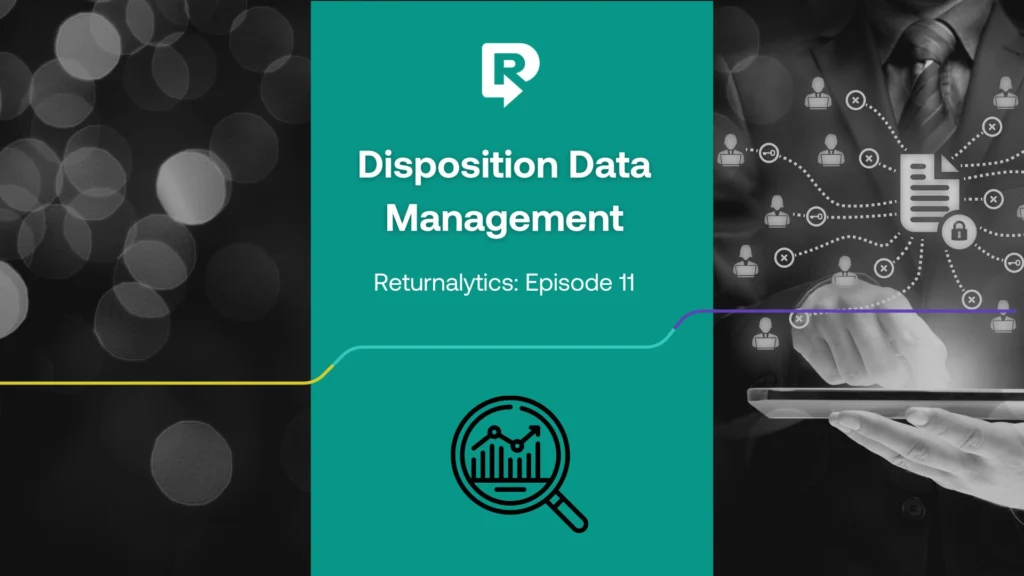Returnalytics: What is Disposition Data Management and How Can You Start Collecting Actionable Data Today?

About the Episode
The Returnalytics podcast discusses the latest retail trends, technology, and best practices for managing an ecommerce business and retail returns.
In this episode, we’ll talk through Disposition Data Management and how you can easily collect actionable feedback to start improving your products immediately.
Disposition Management. What is it?
Dispositions are a set of conditions that classify a returned product’s grade. For example, “New w/ Tags,” “Dirty,” or “Damaged,” etc.
Dispositions help warehouse and operations teams stay on top of inventory levels and know the status of every return.
However, some retailers don’t collect disposition data at all. If you’re not sure where to start, don’t worry! We’ve got you covered. Listen in to learn how you can implement dispositions and start collecting actionable data. Enjoy!
Episode Transcription
Travis Farey – 0:00
Hi, I’m Travis Farey and this is the returns management podcast by ReturnLogic; a show where we connect ecommerce store owners together through casual discussion and examine current myths and trends to keep you up to date on everything happening in the ecommerce world.
Travis Farey – 0:33
So, David, for this episode I’d love to talk to our listeners about disposition management. What do you think about that?
David Gonzalez – 0:40
What position?
Travis Farey – 0:42
What?
David Gonzalez – 0:43
Didn’t you just say, “This Position Management”?… What position are you talking about?
Travis Farey – 0:47
Oh, no I said disposition management not this position management.
David Gonzalez – 0:53
Oh, that thing that Johnny Depp had to do last year?
Travis Farey – 0:56
David, no that’s a deposition.
David Gonzalez – 0:59
Dude… you need to work on your enunciation.
Travis Farey – 1:02
or… you could work on your listening skills.
David Gonzalez – 1:05
Well now my feelings are damaged.
Travis Farey – 1:07
Damaged! That is a great example of a disposition! But let’s touch on that later. First let’s define what a disposition is in the sense of returns.
David Gonzalez – 1:17
Oh, you’re saying disposition okay. Well take those rocks out of your mouth and give our listeners the definition here.

Travis Farey – 1:23
Alright, I guess I can do that. So, dispositions are a set of conditions that classify a returned product’s grade. So, for example it could be, “New w/ Tags,” “Dirty,” or “Damaged”.
David Gonzalez – 1:35
Got it. So, dispositions help warehouse and operations teams stay on top of inventory levels and know the status of every return. That’s helpful, especially because most shoppers choose to exchange their product assuming that their product is going to be resold and they aren’t creating any waste. When in reality, only 10% of returned items actually make it back on the shelves.
Travis Farey – 1:58
Exactly. So, the disposition is assigned to a product by the team that receives returns in the warehouse. And then they dictate what happens with the product.
David Gonzalez – 2:09
Okay, so can dispositions be whatever the retailer chooses in this case?
Travis Farey – 2:14
Yup, that is correct. However, as a retailer, you want to make sure that the dispositions you choose will bring actionable data. If a retailer just chooses “Not sure” as a disposition, they’re not really helping the rest of their team learn what condition the product is in when it was received or what is going to happen to the product now.
David Gonzalez – 2:35
Ahh. Okay, so retailers need to be careful when creating their dispositions so that they can take action on the changes they need to make?
Travis Farey – 2:43
Exactly.
David Gonzalez – 2:44
Okay. So, then what are some good examples of dispositions that retailers can actually use?
Travis Farey – 2:50
That is a great question. Some of the dispositions we recommend are:
- Ready for Resale: The item has no damage can be sold right away.
- Liquidate: The item cannot be resold
- Damaged: The item has been blemished
- Incomplete: The item has missing parts.
- Additional Units: If customers sends back an empty box or wrong item.
- Unassigned: Use this option if you have not decided on what to do with the product.
David Gonzalez– 3:28
Gotcha. And could a retailer just set up as many of these as they want?
Travis Farey – 3:33
Yeah so, that is also correct. However, we recommend using anywhere from 5-8 dispositions. The idea is that you want to collect this actionable data, but you don’t want to make the process too daunting for your team.
David Gonzalez – 3:46
That makes sense.
Travis Farey – 3:48
Right. It’s all about collecting the right data that you can use to act upon.

David Gonzalez – 3:52
Gotcha. So, I guess we mentioned a few reasons there but why are dispositions important for retailers to put in place?
Travis Farey – 4:00
Excellent question. One of the biggest reasons is to be able to quickly get those products back on the market in the case that they’re just able be resold.
David Gonzalez – 4:09
That’s a good point. Totally agree. While it might seem appealing to try to refurbish as many products as possible to be in you know, perfect restock condition, it just simply isn’t scalable when a retailer’s volume grows.
Travis Farey – 4:22
No, it is not. Especially in specific verticals like fashion. As one of our retailers stated about this category, “Fashion is aging – so you don’t want to sit on it too long. You want to turn it to cash fast.” With apparel in particular, by the time a product is returned and processed by the retailer, it may be outdated.
David Gonzalez – 4:44
Hmm, that’s a good point. Okay. What’s another reason?
Travis Farey – 4:48
Yeah so another reason would be accurate inventory levels. Because D2C brands live and die by their inventory.
David Gonzalez – 4:56
That’s so true. And for every minute a product spends in transit, on the warehouse dock, or in a pile somewhere, the retailer is just losing money.
Travis Farey – 5:04
Right. And there is nothing worse than losing money for something that can be fixed.
David Gonzalez – 5:09
Absolutely. Another value add here could be that you’re maximizing your team’s efficiency. So, disposition management makes it easy for employees to receive the products, give the product a grade by marking the disposition, and then ultimately restocking the item in Shopify if appropriate.
Travis Farey – 5:25
That’s another great example. We’ll touch later on how this can be handled easily using ReturnLogic. But are there any other reasons you can think of as to why retailers would want to add disposition management into their returns process?
David Gonalez – 5:40
Yeah. I can think of two. The first one would be to learn about how long the products are lasting for before being returned (This is especially true for warranties and failure rates). The second one basically lets retailers know if there is anything that needs to be done or any manufacturing issues that need to be addressed.
Travis Farey – 6:02
Those are 2 more great examples. And we can touch more on how you as a retailer can put disposition management into place and create a simple process to start collecting this data. But, before we do that, let’s look at how dispositions are currently handled.

David Gonzalez – 6:19
Yeah, great plan. So Travis did you know that some retailers actually don’t collect disposition data at all?
Travis Farey – 6:26
Wow Really? Well then how do they know the status and condition of their products when they are returned?
David Gonzalez – 6:32
They don’t. Well… maybe they have it in another system or place they log it but it’s a big problem for a lot of retailers.
Travis Farey – 6:40
Oh man, that’s almost as bad as handling dispositions on spreadsheets which actually forces the warehouse team to have to review proof of purchase (handwritten), make sure return is eligible, and figure out what to do with it next.
David Gonzalez – 6:55
Exactly, but not only that, if you’re not tracking dispositions, you’re exposing yourself to fraud.
Travis Farey – 7:00
Interesting. How so?
David Gonzalez – 7:02
Well, I’m not going to incriminate myself on this podcast but hypothetically, if dispositions aren’t being tracked, I can buy 3 items, ask for a refund on all 3, then only send 2 items back, and I essentially get a free item.
Travis Farey – 7:18
Hmm. How does that work? And also, did you really do that?
David Gonzalez – 7:23
I’m going to plead the fifth here, but if the warehouse doesn’t have a good way to track the condition a product is in when it gets to the warehouse, and they’re just forced to update a spreadsheet, there’s no good way to track if there was anything out of the ordinary with that return.
Travis Farey – 7:38
Why is that?
David Gonzalez – 7:39
Well, think about it, I’m a shopper, I got my instant refund, money’s back in my account, and I know these tools can’t edit the return, so a savvy shopper such as me, hypothetically could abuse that system.
Travis Farey – 7:52
Well, hypothetically, you’re a swindler.
David Gonzalez – 7:55
Travis It’s like tax loopholes, it’s not my fault they’re there, but I can definitely take advantage of them. Hypothetically.
Travis Farey – 8:03
We’re going to move on before you get subpoenaed.
David Gonzalez – 8:05
It wouldn’t be the first time.
Travis Farey – 8:06
Alright we’ll cut that section out…maybe. So, what’s the answer here, what can retailers actually do to avoid situations like this and shoppers like you, David.
David Gonzalez – 8:18
Great question. So, some returns management platforms actually allow you to collect and relay this information right to the Customer Service team directly through their platform.
Travis Farey – 8:27
Wow. That makes it easy.
David Gonzalez – 8:29
Sure does.

Travis Farey – 8:30
Actually, now that you say that I have an example of how this information was used to solve a big problem.
David Gonzalez – 8:36
Tell us some real-world examples. Let’s Hear it.
Travis Farey – 8:38
Yeah so, I heard from a retailer one time that they were getting a ton of returns on their t-shirts, and they had no idea why. Once looking back at their disposition data, they saw that all of these shirts were being returned with pen marks on them.
David Gonzalez – 8:53
Interesting. I wonder why.
Travis Farey – 8:55
Yeah, so what was happening was, the place that they were storing their shirts was too high up and their employees weren’t tall enough to reach the shirts. So, what they would do to get the boxes down was to stick their pen inside the box, and then pull it down off the shelf. Which caused the pen marks to be on the shirts.
David Gonzalez – 9:13
Wow. You cannot make this stuff up.
Travis Farey – 9:16
No, you can’t. So, the way that they found this out was actually through the disposition data they collected. And then the warehouse manager went down to the warehouse floor and saw what was actually going on.
David Gonzalez – 9:28
Were they able to fix it?
Travis Farey – 9:30
Yup! Through the disposition data they were not only able to figure out why this issue was happening, but they also moved the location of these boxes, so that they were easier to reach and voila the shirts stopped being returned for pen marks.
David Gonzalez – 9:45
That’s pretty impressive.

Travis Farey – 9:46
Yeah, I mean I was blown away, but didn’t you just talk to one of our retailers who was able to do something similar?
David Gonzalez – 9:52
Yeah, I’m glad you asked, this is a pretty crazy story. I was talking with an ops manager for an electronics company, and he had some wild stuff he was able to pull off by blending disposition data with return reasons.
Travis Farey – 10:06
How do you mean?
David Gonzalez – 10:07
So, this company had just started selling on some third-party channels like Amazon, Gamestop, and I think there were a couple others. They were getting all of these shoppers registering products and submitting warranty claims. And obviously electronics is more warranty heavy than exchange heavy.
Travis Farey – 10:27
Yeah, I could definitely see that. But keep going
David Gonzalez – 10:30
So, this company kept getting this one product back across all of their channels and they couldn’t figure out why. Shoppers just kept saying it just didn’t work as promised or it didn’t last as long as advertised. So, these products just kept failing within this 365-day warranty window.
Travis Farey – 10:46
Wow that’s scary to think about.
David Gonzalez – 10:49
Yeah, but they figured it out.
Travis Farey – 10:50
How?
David Gonzalez – 10:51
So, the warehouse and ops teams would inspect each product that came back, scan the barcode, get the serial number, and record the disposition. They would test the products to see if they could replicate the issue or see if they could figure out what was going wrong. And by doing that, they were able to verify if it was failing or not, but this disposition data alone didn’t tell the entire story.
Travis Farey – 11:14
So, what was missing?
David Gonzalez – 11:16
So, they blended their disposition data with their return reason data and ultimately realized that shoppers were submitting claims for this specific SKU because there was a faulty wire.
Travis Farey – 11:29
Yikes… what do you do about that?
David Gonzalez – 11:30
So, they realized this faulty wire was coming from one batch of products being sent over from a manufacturer in Indonesia. They reached out to the manufacturer, let them know it was failing, and then ultimetly they worked on a fix.
Travis Farey – 11:45
So, they ended up figuring it out?
David Gonzalez – 11:48
Yup, they made the changes, and since then they improved their product, dropped the return rate on it, and ultimately were more profitable because they had some root cause analysis.
Travis Farey – 11:57
Wow, that’s like finding a needle in a haystack
David Gonzalez – 12:00
Right?? Not to mention, they only had a handful of product lines but imagine if you sold hundreds or thousands of products. Manually trying to track failure rates or figure out what’s wrong with products would be a nightmare.
Travis Farey – 12:12
Yeah, that would be a nightmare… almost like if the Eagles would’ve won another Super Bowl huh David?
David Gonzalez – 12:19
Alright, I’m done. See Ya.
Travis Farey – 12:20
Did he just leave? Well, I guess that’s all we have for today folks. Thanks for tuning in and we’ll see you on the next one. (Go Birds)
Thanks for listening. Catch another episode, learn more at returnlogic.com, and find us on YouTube and I’ll see you back here on the returns management podcast.
About the Speakers
Travis Farey
Travis is a Growth Marketing Manager at ReturnLogic. Travis graduated from Shippensburg University with a Bachelor of Science in Supply Chain Management & Marketing. Travis has been working for ReturnLogic for over 2 years and started out as a Customer Support Specialist before working his way into Growth Marketing.
David Gonzalez
David is a Director of Growth Marketing at ReturnLogic, previously working as a Product Marketing Manager. David has prior startup experience formerly working at Drip and WhenIWork. He works closely with the Product, Sales, and Marketing teams at ReturnLogic to act as the voice of the customer and how to understand the ecommerce market.
Resources
Ready to transform how your team manages returns?
Speak to a returns specialist to see if you’re a good fit!





